Covered core market concerns from tariff impacts to dollar depreciation.
Written by: Dong Jing, Wall Street Insights
In its latest research report, UBS addressed the top 10 global economic issues that investors are most concerned about, covering core market worries from tariff impacts to dollar depreciation.
On July 8, according to news from the Wind Trading Desk, UBS's research team released a significant report analyzing the top ten issues of concern to investors. The report indicates that the current global economy faces a complex web of challenges, with U.S. tariffs equivalent to a 1.5% GDP tax on importers, and global growth tracking valuations at only a 1.3% annualized growth rate, which is at the 8th percentile historically.
UBS also stated in the report that dollar depreciation and central bank policy adjustments in various countries have become the current market focus. Although UBS holds a cyclical bearish view on the dollar, it does not expect this to mark the beginning of a long-term dollar depreciation trend. The impact of tariffs on inflation is expected to manifest in the July CPI data, while the Federal Reserve faces dual pressures from inflation and employment.
UBS pointed out that European stock markets have a valuation advantage relative to U.S. stocks, with European stock market valuations showing an unusual discount compared to U.S. stocks, with industry-adjusted price-to-earnings ratios 25% lower than those in the U.S., far exceeding the historical normal level of 7%. The bank maintains a strategy recommendation of a benchmark allocation to U.S. stocks and an overweight position in European stocks.
UBS also mentioned in the report the impact of Trump's "Big Beautiful Plan" on the U.S. economy, the general shift of global central banks towards easing policies in response to the growth slowdown caused by tariffs, and the outlook for economic stimulus policies in China in the second half of the year.
Question 1: The impact of tariffs on global growth has already emerged
The report states that the tariffs currently implemented by the U.S. are equivalent to imposing a tax of about 1.5% of GDP on U.S. importers, and even with trade agreements, there is no clear trend of tariff reductions.
Data from the U.S. Treasury shows that based on June's tariff revenue, over $300 billion in tariff revenue is collected annually. According to the Wind Trading Desk, Morgan Stanley previously reported that U.S. tariff revenue has annualized to $327 billion, accounting for 1.1% of GDP.
UBS noted that in April, following the announcement of tariffs, there was a sharp divergence between global hard data and soft data (reaching the highest gap in 27 years), with hard data showing an annualized growth of 3.6%, while soft data only indicated 1.3%. However, starting in May, the two began to converge, as the deterioration of hard data outpaced the improvement of soft data.
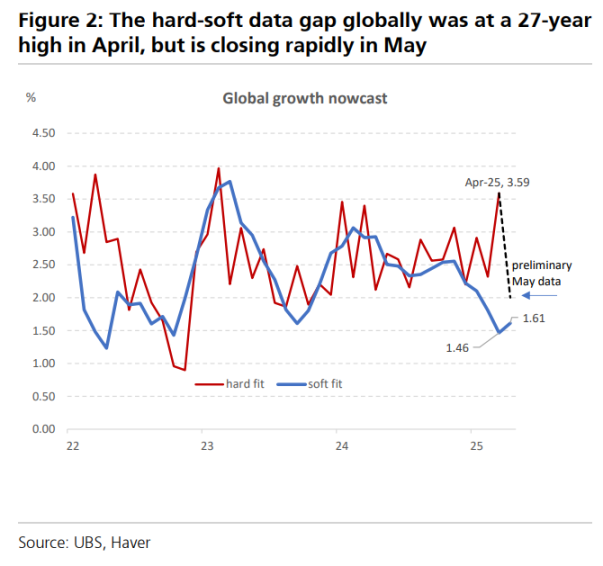
UBS stated that its global growth tracking composite data shows that global growth is only at a 1.3% annualized growth rate, which is at the 8th percentile historically.
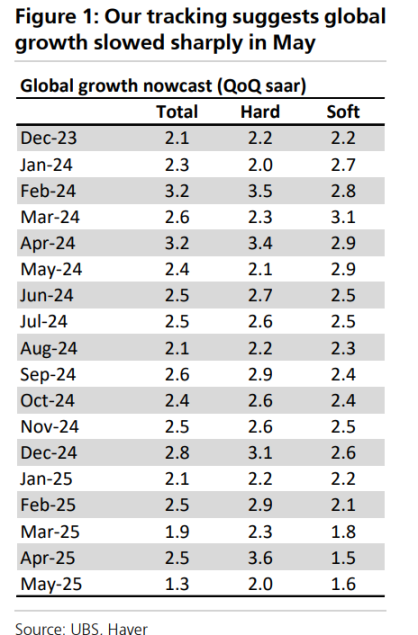
Notably, the decline in the U.S. confidence index has exceeded that of other regions, while European survey data has remained relatively stable, despite both regions facing similar levels of policy uncertainty. In the U.S., survey data is now 1.5 standard deviations below December levels.
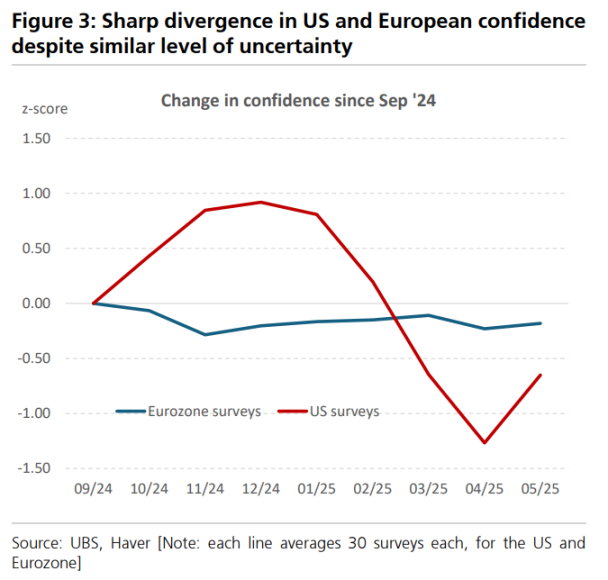
Question 2: How is this dollar sell-off different from previous ones?
UBS holds a cyclical bearish view on the dollar but does not believe this marks the beginning of a long-term depreciation trend.
UBS analysts believe that the depreciation of the dollar is primarily driven by three factors: increased demand for hedging against dollar downside, cyclical slowdown in the U.S. economy, and improving trend growth in other parts of the world. Currently, the first factor is already at play, and the second factor is about to emerge.
Foreign investors hold $31.3 trillion in U.S. long-term securities, of which $6.3 trillion is held by official accounts. UBS estimates that if the foreign exchange hedging ratio increases by 5 percentage points, it would generate a $1.25 trillion dollar sell-off flow, far exceeding the U.S. annual external deficit.
However, UBS emphasizes that the current dollar sell-off does not possess the necessary conditions for past long-term dollar down cycles—improving growth in other regions and reduced risk premiums. This will limit the scope and duration of the current dollar depreciation cycle.
Question 3: The lagging impact of tariffs on inflation
Despite the U.S. implementing large-scale tariffs, equivalent to a 1.1% increase in PCE prices, there has not yet been a clear reflection in official CPI and PCE data.
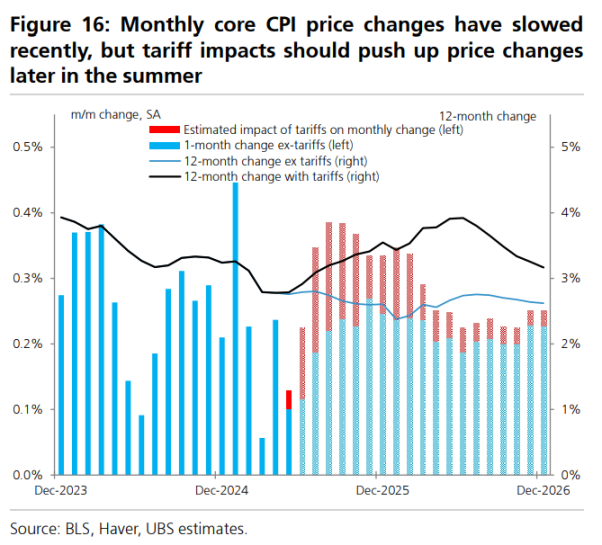
UBS believes this lag is primarily caused by four factors: shipping date exemptions, corporate inventory buffers, slow price transmission of intermediate and capital goods, and the bi-monthly sampling method of CPI.
UBS expects to see a significant impact of tariffs on major inflation indicators only in the July CPI data (to be released in August).
The bank stated that during the Trump 1.0 era, the experience of a 20% tariff on general washing machines in 2018-2019 indicated that it took 2-3 months for the impact of tariffs to show a clear effect in the CPI. The currently implemented 10% general tariff is expected to have a similar inflationary impact timing.
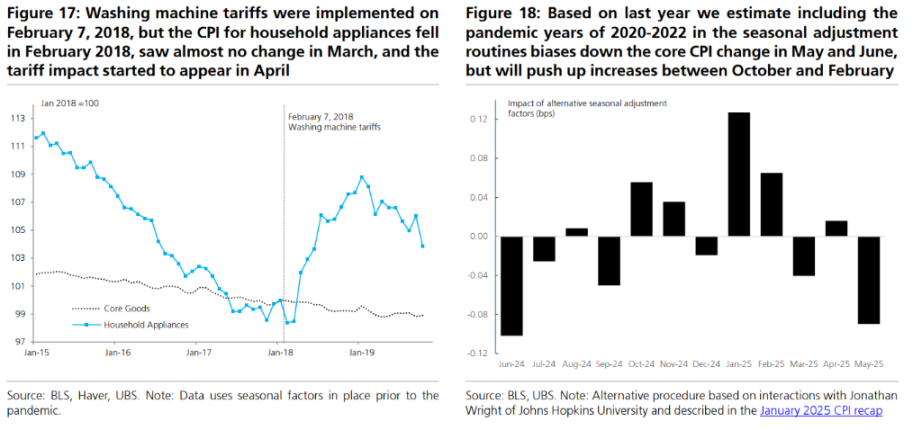
Question 4: How are exporters (globally) responding to U.S. tariffs?
The report states that the potential pre-tariff effects observed in the first quarter and in April/May indicate that a stable state due to price increases and quantity reductions has not yet been reached.
There is a persistent gap in trade data reported by the U.S. and China, and discrepancies exist between container shipping data and official trade data.
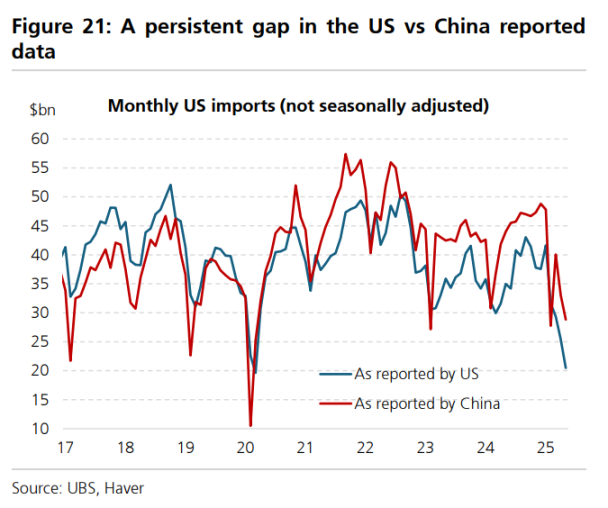
However, there is almost no evidence that foreign exporters are absorbing tariffs by lowering export prices. U.S. import prices fell only 0.5% in April and remained flat in May, indicating that foreign exporters have hardly absorbed tariffs by lowering export prices.
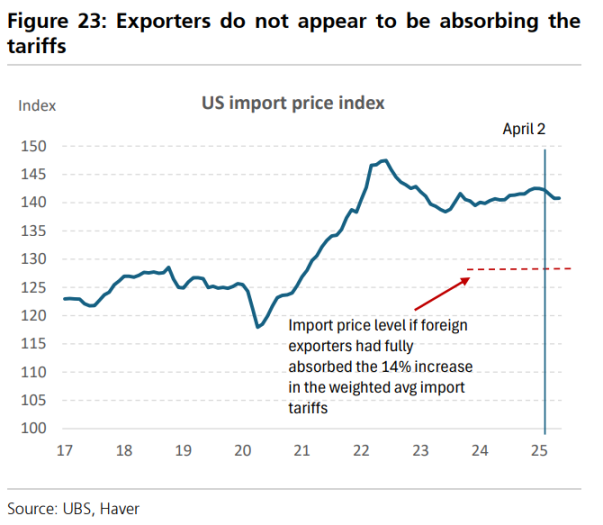
UBS believes that foreign exporters may indeed have absorbed the impact of dollar depreciation on their profits, while U.S. importers bear the majority of the tariff costs. Currently, there are no clear signs of transshipment, but it is still too early to tell.
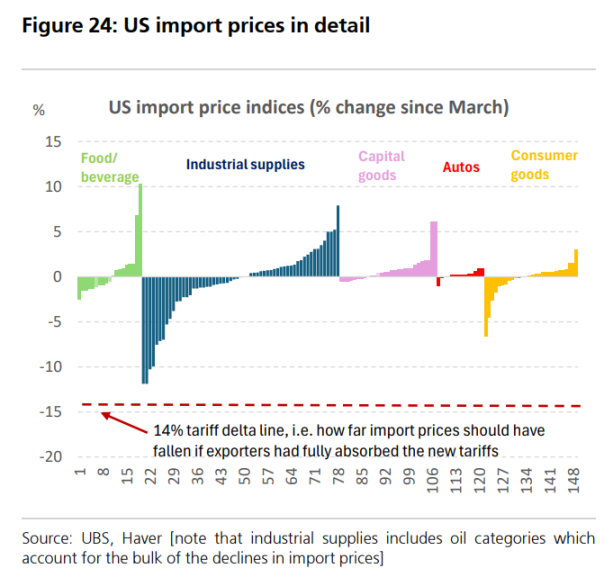
Question 5: Is the U.S. fiscal outlook pushing up global yields?
Currently, the vast majority of changes in the U.S. budget deficit stem from the extension of the 2017 tax cut policy, which has been anticipated since the elections.
UBS is very concerned about the long-term supply of U.S. Treasuries, but historically, demand fluctuations often far exceed supply fluctuations.
If concerns about economic slowdown continue to rise, domestic demand for U.S. Treasuries should increase to a level sufficient to easily absorb this supply.
UBS believes that the bottom for the 10-year Treasury yield should be at 2.75%, even in extremely tight environments.
Question 6: What evidence is there of capital outflows from the U.S.?
The view that foreign investors are reducing their exposure to U.S. assets has spread widely among market participants.
UBS stated that April's TIC data provided evidence of a sell-off of U.S. assets, but it is unclear whether this rotation continued beyond April. The data shows that foreign investors net sold $50.6 billion in U.S. long-term securities, including $18.8 billion in stocks and $40.8 billion in government bonds.
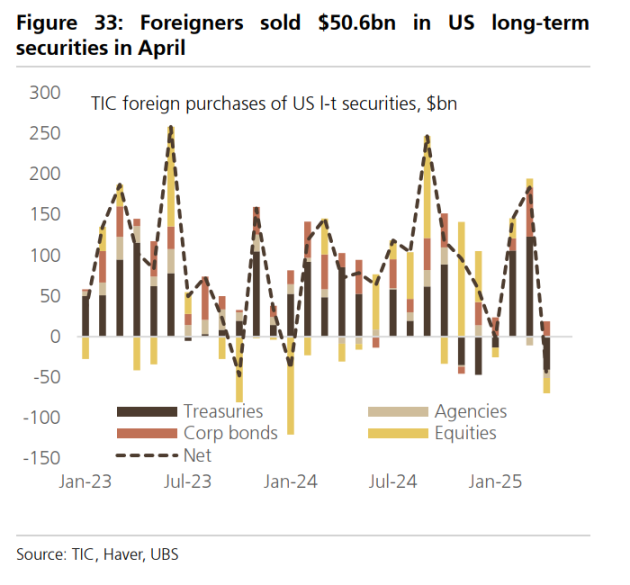
UBS believes that the continued depreciation of the dollar may reflect that global investors have increased their foreign exchange hedging ratios for U.S. assets. Data from Australian and Canadian pension funds on foreign exchange hedging shows that the current hedging ratio remains at historically low levels, with room for further increases.
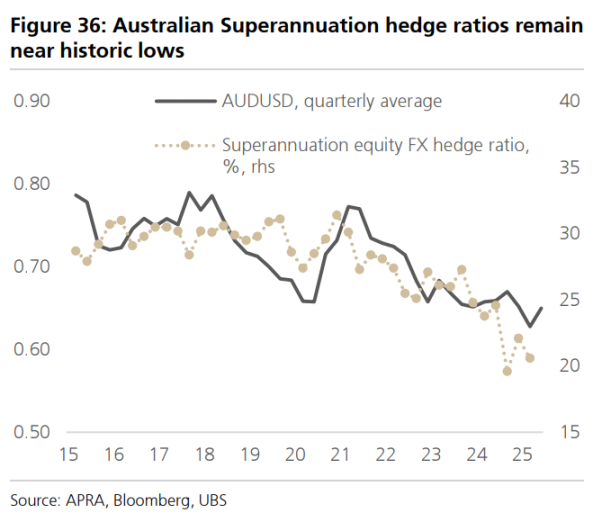
UBS stated that so far, there has been no clear evidence in merger and acquisition announcement data to validate the federal government's claim of over $10 trillion in FDI investment commitments flowing into the U.S.
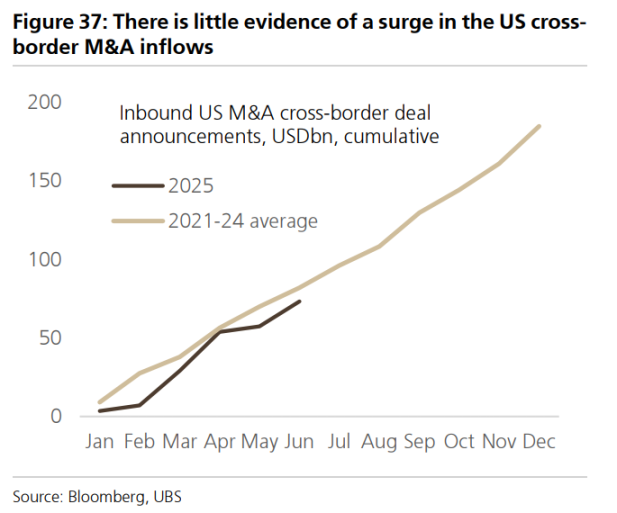
Question 7: How "exceptional" is the U.S. stock market compared to Europe?
When global GDP slows, the U.S. usually performs well, but this time the GDP slowdown is centered on the U.S., and the Eurozone has unexpectedly performed much better than the U.S., although this has not been fully reflected in market trends.
The U.S. stock market is exceptionally poor compared to the Eurozone in terms of valuation (abnormally expensive relative to the EU), fiscal conditions, and household excess savings, as follows:
The adjusted price-to-earnings ratio of the U.S. stock market relative to Europe is 25% higher, while the historical average is only 7%.
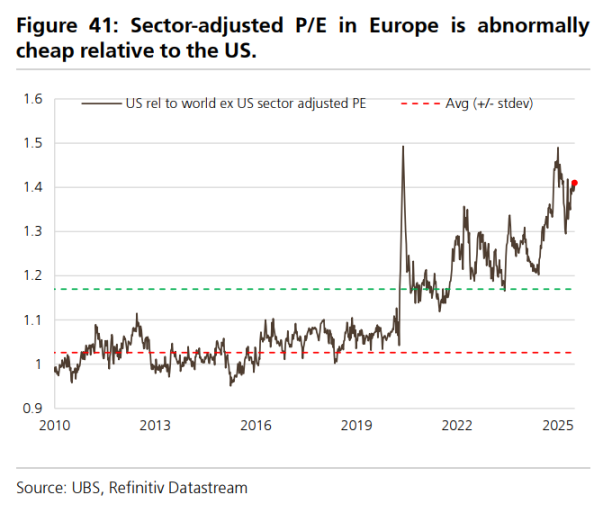
The total return in Europe (dividends plus buybacks) is currently 4.4%, while in the U.S. it is 2.8%.
Fiscal conditions and household excess savings in Europe are significantly better than in the U.S., with Europe's excess savings at about 10% of GDP, while the U.S. is only 2%.
UBS stated that the U.S. is no longer "exceptional" compared to the Eurozone in terms of buybacks (as a percentage of market value) and GDP growth (slightly lower than the EU in 2026).
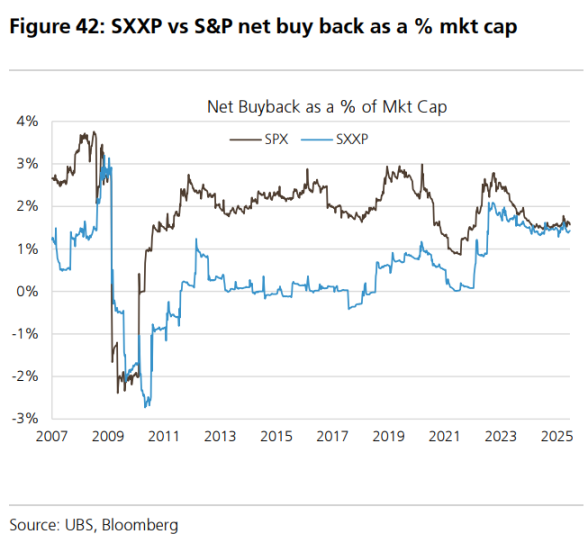
Question 8: Does the "Big Beautiful Plan" help or hurt U.S. growth?
UBS stated that the plan increases the deficit before 2026, after which it shifts to a reduction, totaling a $400 billion reduction in the deficit over ten years.
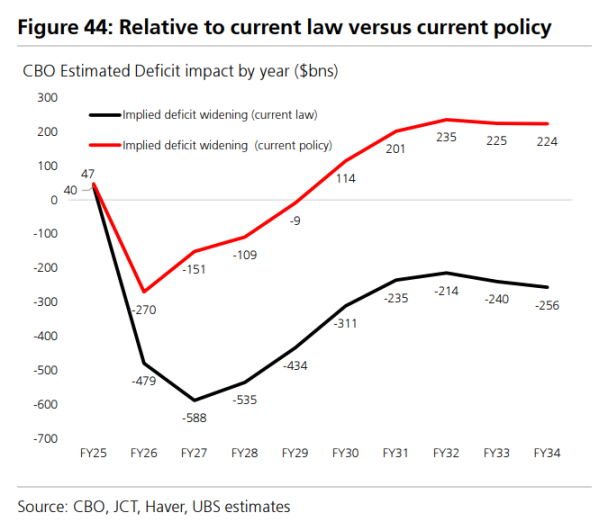
The bank expects that the "Big Beautiful Plan" will contribute approximately 45 basis points to growth before 2026, after which the fiscal drag will begin to manifest.
The plan expands the business provisions of the 2017 tax reform, including full expensing, R&D tax credits, and changes in deductions, with student loan reductions being an important recent source of funding.
Question 9: How are central banks responding to the global tariff escalation?
The actual impact of tariff shocks differs significantly from expectations, primarily manifested in dollar depreciation and a lack of retaliatory measures. This fundamentally alters economic outcomes, including central bank policy orientations.
For central banks outside the Federal Reserve, the current situation is much simpler than the previously feared stagflation scenario. The tariff shock clearly constitutes a negative growth shock, and it may also be a deflationary shock. Since April 2, the average one-year interest rate in developed markets has fallen by 30 basis points, while emerging markets have seen a decline of about 50 basis points.
UBS's in-depth analysis model shows that among the G3 central banks, the European Central Bank's sentiment has turned the most dovish, while the Bank of Japan has begun to worry about growth. The Federal Reserve, on the other hand, faces a dilemma.
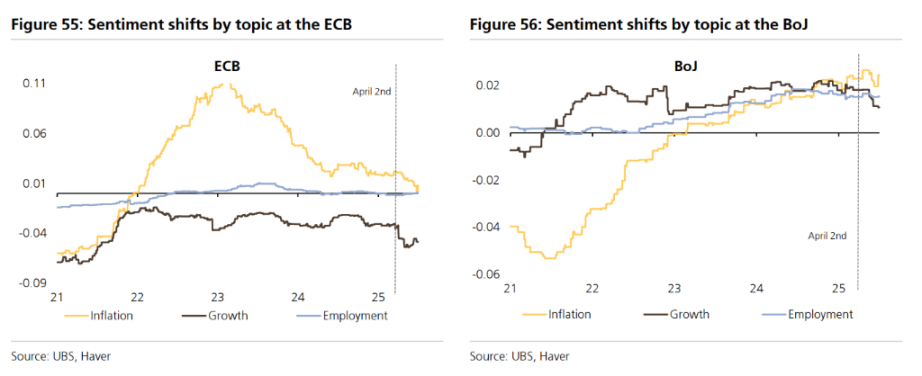
If inflation rises more than unemployment, the Federal Reserve's policy rules suggest raising interest rates. However, if tariffs primarily represent a one-time price level shock, the Federal Reserve may choose to prioritize addressing higher unemployment. Current indications suggest that the Federal Reserve is inclined to support the labor market.
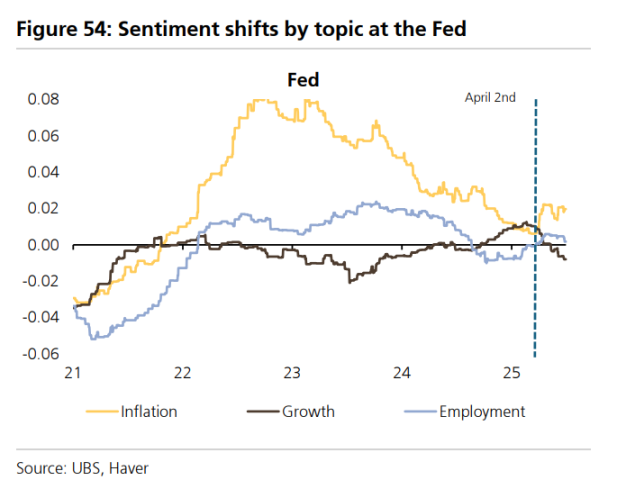
Question 10: How many stimulus measures has China implemented, and how many are yet to come?
China set a GDP growth target of "around 5%" at the National People's Congress in March and announced moderate policy stimulus measures. The broad fiscal deficit has expanded to 1.5-2% of GDP, with monetary and credit policies set to "moderately loose." UBS expects policy rates to be cut by 30-40 basis points.
In terms of policy implementation, the central bank lowered the policy rate by 10 basis points in May, reduced the reserve requirement ratio by 50 basis points, and announced new relending tools to support consumption and innovation. The net issuance of government bonds in the first half of the year was strong, driving credit growth in June to an 8.8% year-on-year increase.
UBS estimates that China's broad fiscal deficit expanded to 1.1% of GDP in the first half of the year compared to the previous year. It is expected that the remaining planned fiscal stimulus (0.5-1% of GDP) will be delivered in the second half of the year, and additional fiscal stimulus exceeding 0.5% of GDP may be introduced, potentially by the end of the third quarter.
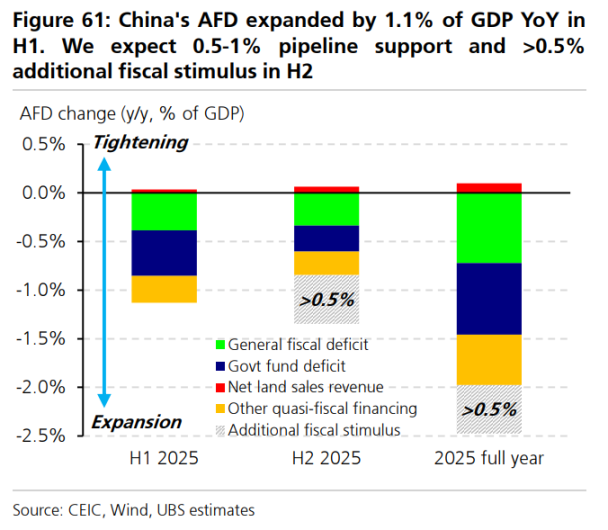
Additionally, UBS expects a further reduction of 20-30 basis points in policy rates.
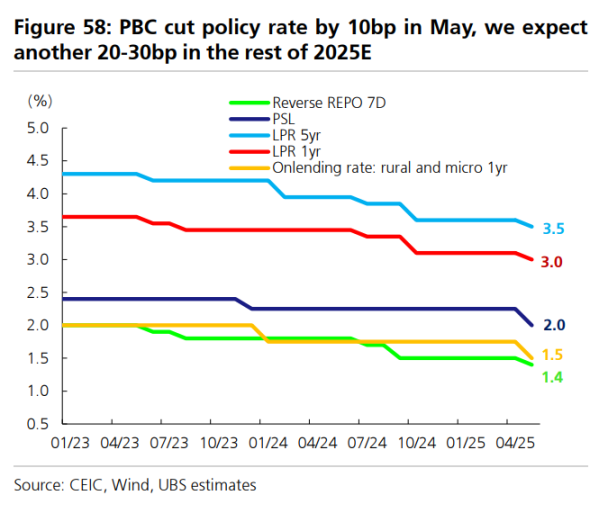
免责声明:本文章仅代表作者个人观点,不代表本平台的立场和观点。本文章仅供信息分享,不构成对任何人的任何投资建议。用户与作者之间的任何争议,与本平台无关。如网页中刊载的文章或图片涉及侵权,请提供相关的权利证明和身份证明发送邮件到support@aicoin.com,本平台相关工作人员将会进行核查。




